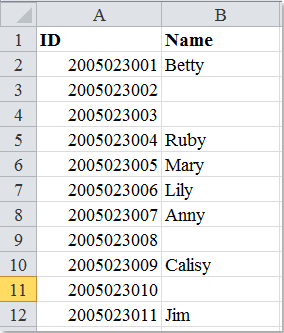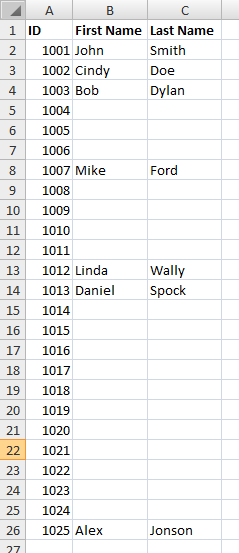

- #FIND MISSING SEQUENTIAL NUMBERS IN EXCEL HOW TO#
- #FIND MISSING SEQUENTIAL NUMBERS IN EXCEL INSTALL#
- #FIND MISSING SEQUENTIAL NUMBERS IN EXCEL FULL#
- #FIND MISSING SEQUENTIAL NUMBERS IN EXCEL CODE#
- #FIND MISSING SEQUENTIAL NUMBERS IN EXCEL SERIES#
Thanks very much.If all 300000 CSV files are in current directory on executing the batch file, this batch code would do the job.
#FIND MISSING SEQUENTIAL NUMBERS IN EXCEL SERIES#
For example, does the dfStartIndex represent the 70th row in the original dataset, with 296 rows followed, or does it represent the 70th row in the runs dataframe? I want to find out the longest consecutive days with no NA value, and plot the time series on a figure. Then I got the dfExtracted and runs results here, but I don't know what they represent. The difference is that I did not use the desired length as a screening criterion. In one of my datasets, I filled the missing dates with NA values for the Data column, and followed the rle function as in the post you mentioned. I think it is better to fill the missing dates in my dataset, and then to find out the longest continuous time period? In my case, I'd like to find out all four columns of the longest time period with continuous data.

Thanks, I read the thread and think it is a little different. Your answer for the question about missing dates works. Referenced from: /Library/Frameworks/R.framework/Versions/3.4/Resources/library/rJava/libs/rJava.soġ: package ‘rJava’ was built under R version 3.4.4Ģ: running command '/usr/libexec/java_home' had status 1īut I used readxl package and it worked. )Įrror: unable to load shared object '/Library/Frameworks/R.framework/Versions/3.4/Resources/library/rJava/libs/rJava.so':ĭlopen(/Library/Frameworks/R.framework/Versions/3.4/Resources/library/rJava/libs/rJava.so, 6): Library not loaded: /Library/Java/JavaVirtualMachines/jdk-9.jdk/Contents/Home/lib/server/libjvm.dylib onLoad failed in loadNamespace() for 'rJava', details:Ĭall: dyn.load(file, DLLpath = DLLpath. No Java runtime present, try -request to install.Įrror: package or namespace load failed for ‘rJava’: Unable to find any JVMs matching version "(null)". var/folders/rs/dzg78fb95339szp7hlnrrc6m0000gn/T//RtmpiqGQkR/downloaded_packages
#FIND MISSING SEQUENTIAL NUMBERS IN EXCEL INSTALL#
There is a binary version available but the source versionĭo you want to install from sources the package which needs compilation?Ĭontent type 'application/x-gzip' length 638092 bytes (623 KB) I got this error when trying to install the rJava package. The lubridate package has a concise way of creating date sequences time_span % tibble::enframe(time_span) %>% transmute(Date = value)Īnd, to find the missing dates time_span %>% anti_join(df.xlsx2)
#FIND MISSING SEQUENTIAL NUMBERS IN EXCEL FULL#
# wouldn't ordinarily give full pathname, but reprex doesn't play nice with here()ĭf.xlsx2 % mutate(Date = make_date(year = Year, month = Month, day = Day)) %>% select(Date, Data)Ĭreated on by the reprex package (v0.3.0) SuppressPackageStartupMessages(library(lubridate)) suppressPackageStartupMessages(library(dplyr)) (BTW: this is a simple enough problem that it doesn't require a reproducible example, called a reprex, but when in doubt, it's always a good idea to include one. Renaming is easier, so let's start there. #> The following object is masked from 'package:base':Ĭonsider using readxl as an alternative to xlsx and you can avoid having to deal with rJava. What happens if you run install.packages("rJava")įor changing the name of the fourth column in your data frame and finding the missing dates, please see the code below. It is better to ask one question per thread.įor your problem with loading the xlsx package, the error mentions that the rJava package is missing.
#FIND MISSING SEQUENTIAL NUMBERS IN EXCEL HOW TO#
In the example, there are two missing days -4, there must be other missing days after and before, how to check which days are missing in R? It is impossible to check manually for these datasets and so many days.


The actual length should be 10227, but there are only 10016 rows that are displayed on the excel sheet. Package ‘xlsx’ was built under R version 3.4.4ĭf.xlsx1 Year Month Day Value (total/day)įor example, in the dataset above, I used the code below to generate the same dates in between. > library(xlsx)Įrror: package or namespace load failed for ‘xlsx’ in loadNamespace(i, c(lib.loc. I checked from the time length, and found that the excel sheet has many fewer rows than the actual length between two dates. Also, there are missing rows in some days, but I don't know which days are missing. Second, how to rename the "Value (total/day)" column to a different name, such as change "Value (total/day)" to "Data". First, I have problem loading the xlsx package and read in the data. Each dataset contains one sheet, with four columns displaying "year", "month", "day" and "Value (total/day)".


 0 kommentar(er)
0 kommentar(er)
